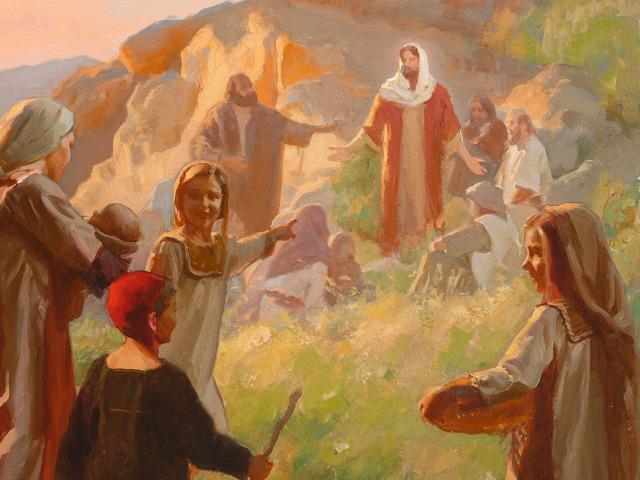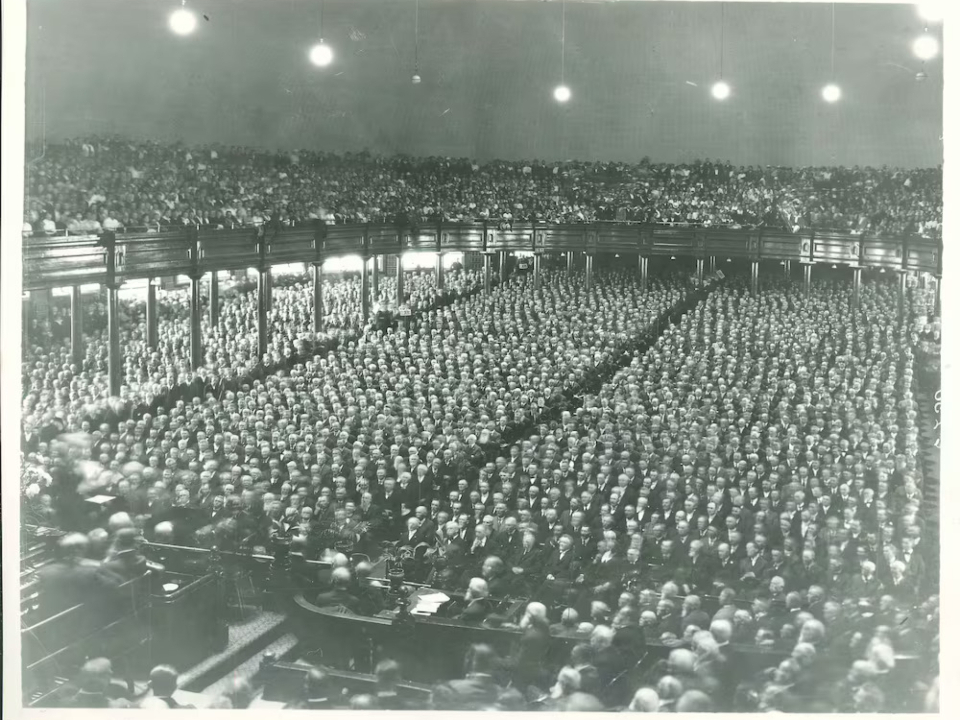
100-years-conference-broadcast-1.jpg
A photo of general conference held in the Salt Lake Tabernacle circa 1924. General Conference was broadcast over the radio for the first time on October 3, 1924. Photo from Church History Catalog.2024 by Intellectual Reserve, Inc. All rights reserved.This story appears here courtesy of TheChurchNews.com. It is not for use by other media.
By Rachel Sterzer Gibson, Church News
The first general conference of The Church of Jesus Christ of Latter-day Saints took place on a small farm in the forests of western New York. About 40 Church members — along with some friends and other interested people — crowded into the log home of Peter and Mary Whitmer on Wednesday, June 9, 1830, in the township of Fayette in Seneca County, New York.
At that time, the entire Church had fewer than a dozen priesthood holders. The minutes for that meeting reveal that Joseph Smith read the “articles and covenants” — or what would become Doctrine and Covenants 20 — which were received by unanimous voice of the entire congregation.
Oliver Cowdery ordained Samuel Smith an elder; then Joseph Smith Sr. and Hyrum Smith were ordained priests.
That day began the heritage of the general conference of the Church.
Today, more than 17 million Latter-day Saints — in addition to friends and associates of all faiths, beliefs and backgrounds — are invited twice a year, during the first weekends of April and October, to hear messages from Church leaders focused on Jesus Christ and His gospel.
Each two-day event consists of five sessions, generally two hours, and can be watched live in close to 70 languages, or consumed later after it’s translated into more than 100 languages.
The process of accommodating a handful of people in 1830 to now — where it is watched by millions around the world — has been remarkable, said Christine Marin, an audiovisual specialist in the Church History Department. “It’s so interesting how it’s evolved.”
That evolution has included many milestones and technological innovations. This year marks the 100th anniversary of broadcasting the Church’s general conference on radio, the 75th anniversary of general conference broadcast via television and the 25th anniversary of live broadcast via the internet.
Marin noted, “The Church has always been trying to be on the cutting edge of technology so that it can get the message out to everybody.”
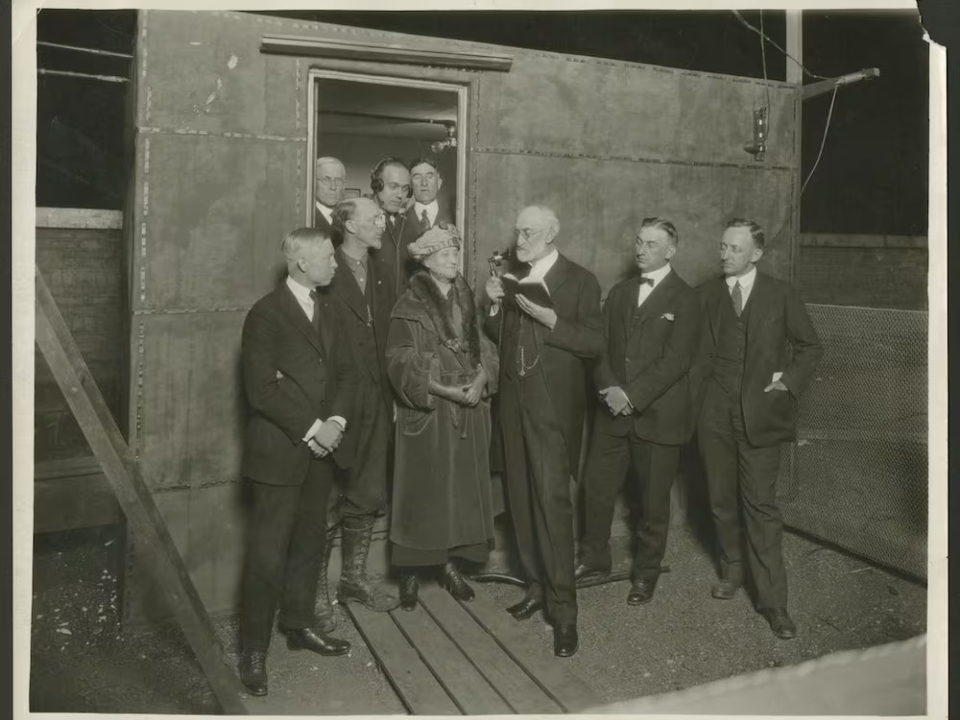
100-years-conference-broadcast-2.jpg
Church President Heber J. Grant, right, speaks into a microphone as part of the first radio broadcast on KZN (now KSL) on May 6, 1922. Elder George Albert Smith, middle left, and Augusta Grant, center, listen and look on. Photo provided by Church History Library.2024 by Intellectual Reserve, Inc. All rights reserved.The Evolution of General Conference
At first, conferences were convened at the request of the First Presidency. “In 1830, they had two conferences. The next year, they had 40, because conferences were called as needed” at different times and locations, Marin said.
The April 6, 1833, general conference, for example, was held at the ferry on the Big Blue River in Jackson County, Missouri. It was not until Church headquarters moved to Nauvoo, Illinois, that the pattern was set of holding conferences in April and October.
Until 1977, conference was always held on the 6th of April — the anniversary of the organization of the Church — no matter the day of the week, and general conference lasted three or more days.
After the Saints’ arrival in the Salt Lake Valley, the membership soon outgrew a single venue. The Church’s first foray in trying to share the messages of conference beyond the walls of the Salt Lake Tabernacle involved a man learning shorthand and taking meticulous notes. “[At that time] quite often the Brethren did not write their talks. They spoke from the pulpit extemporaneously,” Marin said.
Beginning in 1850, the man’s notes were transposed and printed in the Deseret News. “In 1897, they started doing conference reports, and they’d print up all the talks, and you could buy the little pamphlet for 10 cents,” Marin said. “Then they would distribute it to various stakes in the West, which included California, Washington state, Idaho and, of course, all up and down Utah.”
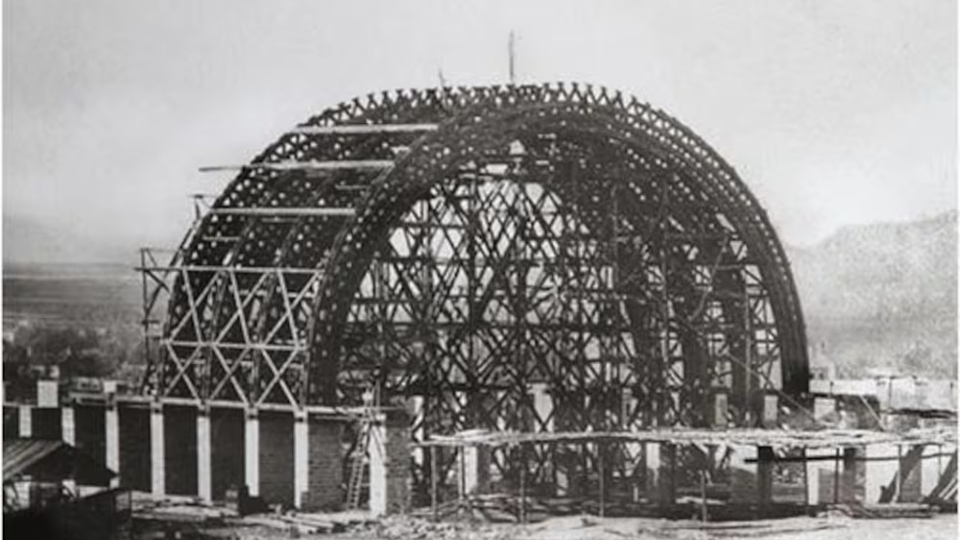
100-years-conference-broadcast-3.jpg
Henry Grow, who built railroad bridges in Pennsylvania prior to moving to Salt Lake, used trusses to construct the roof of the tabernacle without internal pillars. The roof is 150 feet wide, 250 feet long and 9 feet thick. Photo provided by Robert Grow, courtesy of Church News.2024 by Intellectual Reserve, Inc. All rights reserved.The First General Conference Broadcast
General conference was first broadcast on the radio in 1924, although some accounts claim it was 1923. For example, on April 8, 1923, Church President Heber J. Grant noted during conference that all the seats in the Tabernacle were occupied, as well as the aisles, and that 4,000 people standing on the grounds would be listening to the sermons “conveyed by radio.”
However, “they used the term ‘radio’ because nobody understood an acoustical system,” Marin explained. While they were able to amplify the sound to other audio speakers on Temple Square, “it was a closed system.”
It wasn’t until the next year, during the 95th Semiannual General Conference, on October 3, 1924, that the local radio station KFPT — which would become KSL in 1925 — broadcast conference in its entirety.
At that time, President Grant stated: “The exercises of today and throughout the conference are to be broadcasted; and it is estimated that in the neighborhood of a million people will be able to hear all that is said, provided they are listening in during the conference sessions. The radio is one of the most marvelous inventions man knows anything about. To have the voice carried for thousands of miles seems almost beyond comprehension.”
Marin explained that as KSL slowly gained more wattage, the base of people who could listen to the broadcast expanded from the Salt Lake Valley “outward and upward.”
At one point, KSL began rebroadcasting conference at night because when the sun went down, the sound could travel a farther distance.
“There are accounts of people saying they could hear general conference while aboard a ship to Hawaii in the evenings,” Marin recounted.
Eventually the Church began to record conference on transcription discs and send them to New York City, where an affiliate radio station would broadcast it across the Atlantic Ocean to England and Spain.
It was also during this time that the Church began to get more strategic about how long a speaker could take or when to have a musical number. “They had to make sure the local radio station could give their identification out over the airwaves,” Marin said.
Television, Satellite and the Internet
Twenty-five years after the first radio broadcast, conference was broadcast over television for the first time on Friday, September 30, 1949, on KSL-TV.
In the opening talk of the 120th Semiannual General Conference, Church President George Albert Smith noted that the proceedings were being shared through television. “We live in a wonderful age,” he commented.
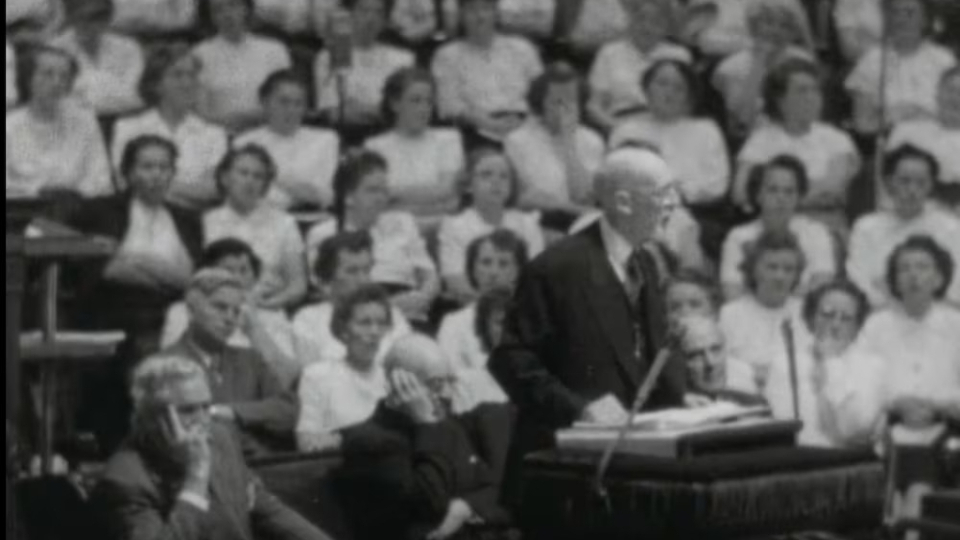
100-years-conference-broadcast-5.jpg
Church President George Albert Smith speaks from the pulpit in the Salt Lake Tabernacle in the opening session of October 1949 general conference — the first time conference was broadcast via television — on September 30, 1949. Photo from Church History Catalog.2024 by Intellectual Reserve, Inc. All rights reserved.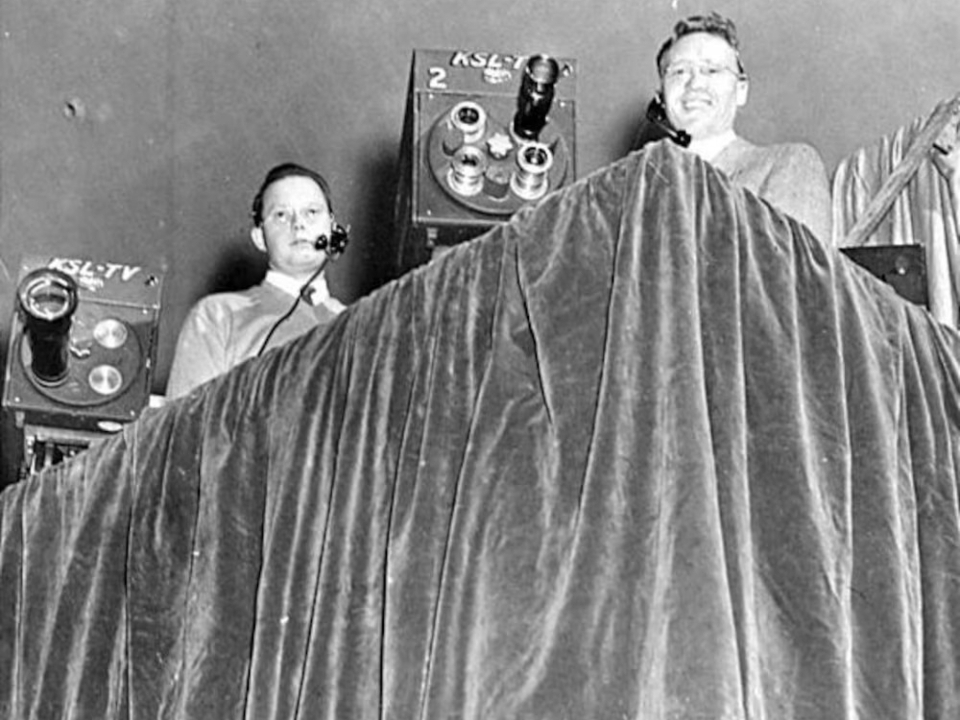
100-years-conference-broadcast-6.jpg
KSL employees John Powell and David Searle film the first televised general conference in October 1949. Photo from Deseret News Archives, courtesy of Church News.Copyright 2024 Deseret News Publishing Company.In that conference, President Joseph Fielding Smith, who was then a member of the Quorum of the Twelve Apostles, quoted the Book of Mormon prophet Alma, who expresses his desire to have “a voice of thunder” to reach the ends of the earth with the news of the gospel of Jesus Christ (Alma 29:1-2).
“If Alma were here today,” President Joseph Fielding Smith said, “I know he would be very grateful for the facilities and the opportunities that we have to reach the peoples, not only who are assembled but also scattered abroad.”
Marin noted that in the early days of film, mainly members of the First Presidency and the Quorum of the Twelve were filmed as individual speakers. There are gaps in video coverage until the 1970s.
The first audio-only satellite broadcast of general conference occurred Sunday, April 9, 1967, via the Lani Bird satellite orbiting 22,000 miles above the Pacific Ocean. Speakers at the conference included Elders N. Eldon Tanner, Alvin R. Dyer, Mark E. Petersen and Howard W. Hunter. The Tabernacle Choir, under the direction of Richard P. Condie and with Alexander Schreiner at the organ, provided the music.
The first satellite audio and video broadcast occurred Friday, October 3, 1975. Speakers included President Spencer W. Kimball and Elders Vaughn J. Featherstone, Hartman Rector Jr., Robert L. Simpson and Bruce R. McConkie. The Tabernacle Choir, under the direction of Jerold Ottley and with Schreiner at the organ, provided the music.
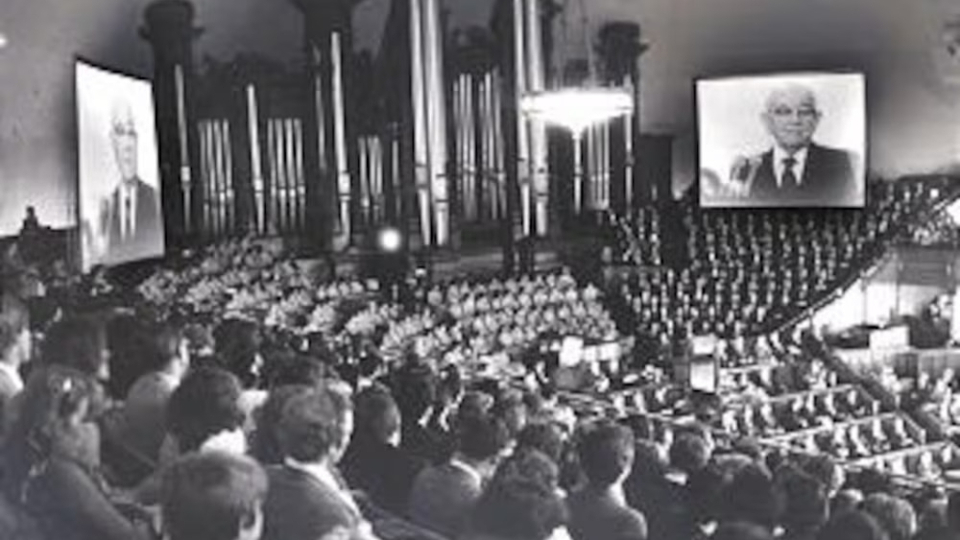
100-years-conference-broadcast-7.jpg
Church President Spencer W. Kimball speaks in the first satellite address. Photo by Dell Van Orden and Howard C. Moore, courtesy of Church News.Copyright 2024 Deseret News Publishing Company.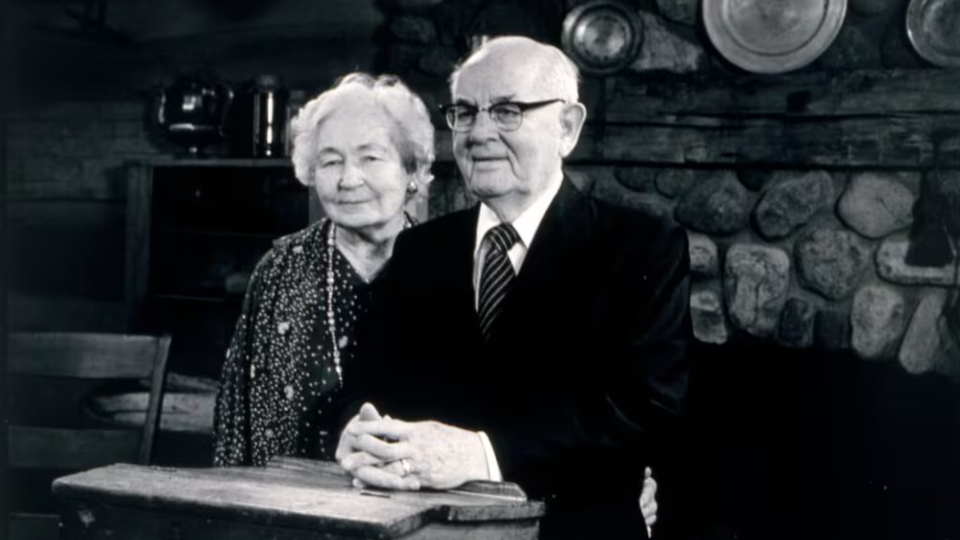
100-years-conference-broadcast-8.jpg
President Spencer W. Kimball and his wife, Sister Camilla Kimball, visit the Peter Whitmer Sr. Farmhouse in Fayette, New York — the location of the first general conference of the Church.2024 by Intellectual Reserve, Inc. All rights reserved.During an address to regional representatives in 1974, President Kimball noted the satellites “stationed high in the heavens. ... Certainly these satellites are only the genesis of what is in store for the future of worldwide broadcasting” (Ensign, October 1974, pp. 10-11).
On October 2, 1999, live video of conference was made available on the internet. Although little was said of the internet broadcast during that conference, just two years later, during the October 2001 general conference, Church President Gordon B. Hinckley, with emotion in his voice, shared that he could “scarcely restrain my emotions as I think of what the Lord has done for us.”
Said President Hinckley: “I wish all of us could be assembled under one roof. But that is not possible. I am so deeply thankful that we have the wonders of television, radio, cable, satellite transmission and the internet. We have become a great worldwide Church, and it is now possible for the vast majority of our members to participate in these meetings as one great family, speaking many languages, found in many lands, but all of one faith and one doctrine and one baptism.”
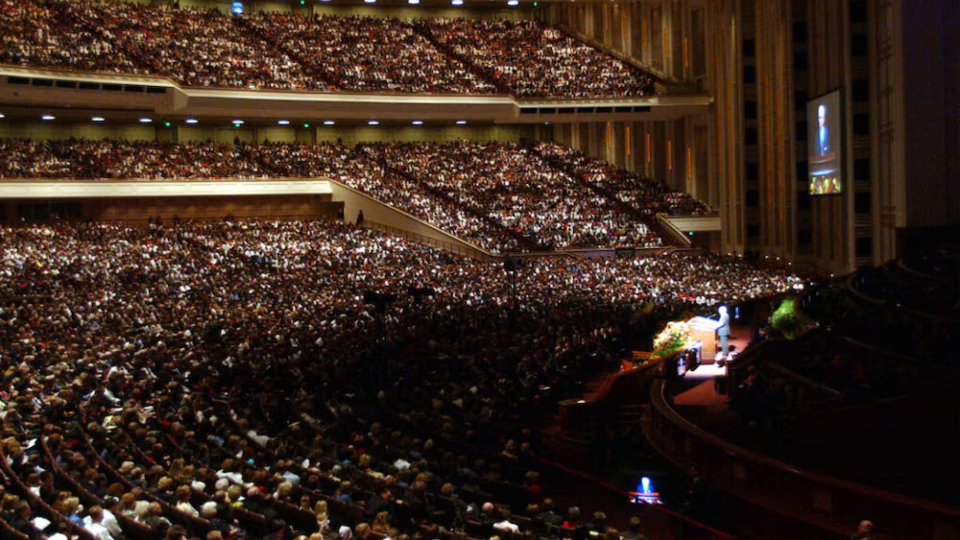
100-years-conference-broadcast-9.jpg
President Gordon B. Hinckley speaks during the Sunday morning session of the 171st Semiannual General Conference on Sunday, October 7, 2001. Photo by Jason Olson, courtesy of Church News.Copyright 2024 Deseret News Publishing Company.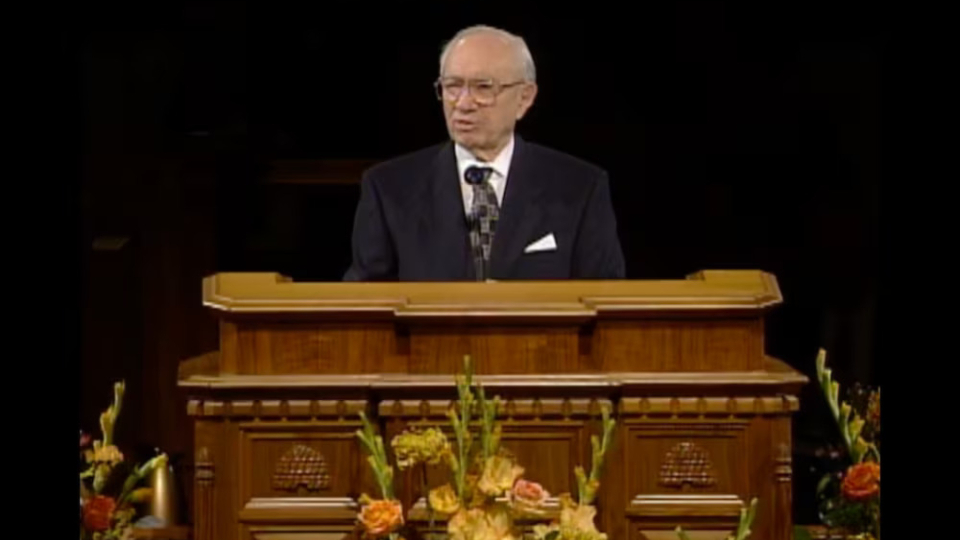
100-years-conference-broadcast-10.jpg
President Gordon B. Hinckley speaks on October 2, 1999, during the opening session of October 1999 general conference, the first time conference was broadcast on the internet.2024 by Intellectual Reserve, Inc. All rights reserved.Sharing the Words of the Lord
In an interview with the Church News in 2021, Elder Brook P. Hales, a General Authority Seventy and secretary to the First Presidency, shared that Church employees and volunteers work an estimated 91,000 hours to prepare for, host, broadcast and record the two-day, five-session general conference.
Why does the Church expend so many resources to share general conference?
Elder Hales explained that it’s because of Latter-day Saints’ belief that the Prophet and Apostles are sharing the words of the Lord. “I’m not sure there’s any other organization — religious or otherwise — that has such a gathering where there is a centralized opportunity for the leaders of the Church to reveal, as it were, to the members and to those who are listening, the mind and will of the Lord … for our instruction and guidance for the next six months.”
During her 30-year career at the Church History Department, Marin said, she has studied each general conference and has “read every talk there is. I’ve seen all the footage. I’ve listened to all the audio and video.”
One of her takeaways from studying the 194-year history of conference is that while the transmission may change, the substance of general conference does not. The leadership of the Church is teaching truth, Marin said. “They’re teaching us the gospel. And we’re just trying to share it with the world.”
Things You Might Not Know About General Conference
- The only general conference in the 20th century to be canceled completely was in October 1957, because of the Asian flu epidemic that was sweeping the country. Influenza also postponed the April 1919 conference till June. That conference, in solemn assembly, sustained Heber J. Grant as President of the Church.
- The first woman to speak in a general session of conference was Lucy Mack Smith on October 8, 1845. The newspaper at the time states: “Mother Lucy Smith, the aged and honored parent of Joseph Smith, having expressed a wish to say a few words to the congregation, she was invited upon the Stand. She spoke at considerable length, and in an audible manner, so as to be heard by a large portion of the vast assembly.” (See “At the Pulpit: 185 Years of Discourses by Latter-day Saint Women,” Lucy Mack Smith, “This Gospel of Glad Tidings.”)
- The youngest person to speak in general conference was a 13-year-old deacon named Ross Farnsworth on April 5, 1969. At the time it was not uncommon for Aaronic Priesthood holders to speak in the priesthood session.
- There have been 10 non-members who have spoken in a general session of conference, including Gen. Charles F. Summerall, the chief of staff of the U.S. Army in 1927, and Sir Alexander Fleming, the discoverer of penicillin in 1954.
— Source: Church History Library, General Conference Research Guide
Copyright 2024 Deseret News Publishing Company.
